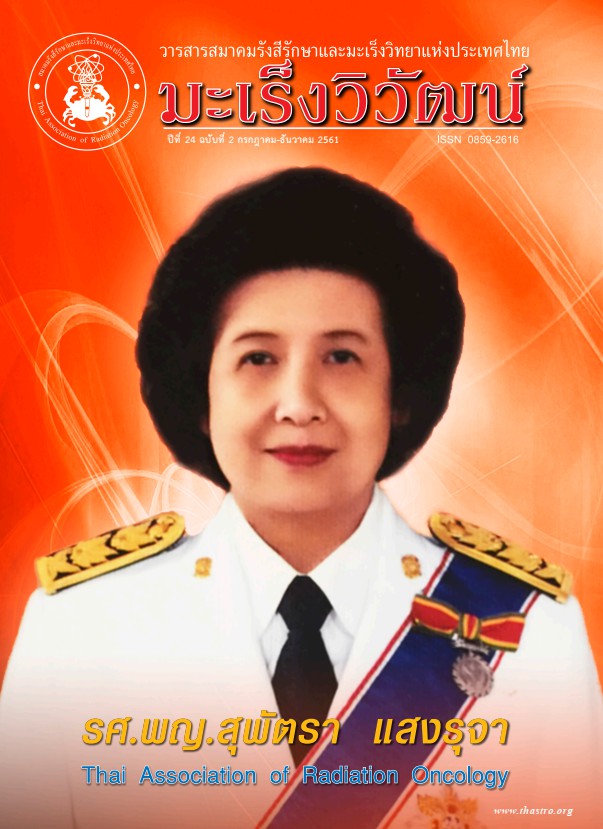The reference air kerma rate comparison between measurements and certificates for Ir-192 high dose rate
Keywords:
Ir-192 HDR, pellet source, reference air kerma rateAbstract
Background: Brachytherapy patients should be obtained accurate dose in order to treat as intended. Objective: To report retrospective comparison of measured reference air kerma rate (RAKR) for Ir-192 HDR(high dose rate) pellet source with the certificate issued by the manufacturer. Materials and methods: The well-type ionization chamber was a measurement tool of 22 RAKR for Ir-192 pellet sources MicroSelectron V2 type. It was connected to the electrometer to read collected charge. The pellet dwell position that presented the maximum reading of collected charge value was searched. The collected charge reading at maximum reading dwell position was performed for 3 times for each 300 seconds dwell time. The averaged charge readings were corrected for source transit effect calibrated, air density and charge recombination. The reading was calculated to RAKR and compared with the manufacturer's one. Results: The maximum charge reading position was found at 19th pellet dwell position. The RAKR differences between measurement and certification were ranged from -0.76% to+1.15% with the average value of -0.02±0.56%. The measured RAKRs were less than the certificate done for 12 out of 22 pellets. The differences between measured and manufacturer’s RAKRs were larger than 1% noticed for 2 out of 22 pellets. Conclusion: Each replacement of the new source, the medical physicist must verify the manufacturer’s RAKR. It is an important process as the quality control in brachytherapy treatment. This study shows that the differences between measured RAKR and the certificate are in the range from -0.76% to +1.15% which is not more than ±3% as required by universal standard.
References
International Atomic Energy Agency. IAEA-TECDOC-1079,calibration of brachytherapy sources – guidelines on standardized procedures for the calibration of brachytherapy sources at SSDLs and hospitals. Vienna: International Atomic Energy Agency;1999.
International Commission on Radiation Units and Measurements. Dose and volume specification for reporting intracavitary therapy in gynaecology, ICRU report 38. Bethesda: ICRU Publications; 1985.
International Commission on Radiation Units and Measurements. Dose and volume specification for reporting interstitial therapy, ICRU report 58. Washington, DC: International Commission on Radiation Units and Measurements; 1997.
International Commission on Radiation Units and Measurements. Dosimetry of beta ray sources and low energy photon brachytherapy sources, ICRU report 65. Bethesda: International Commission on Radiation Units and Measurements; 2001.
Netherlands Commission on Radiation Dosimetry. Code of Practice for Quality Assurance of Brachytherapy with Ir-192 Afterloaders, NCS report 30; 2018.
7 ACR–AAPM.ACR–AAPM Technical Standard for the performance of high-dose-rate brachytherapy physics: Revised 2015 (Resolution 50)*.
Kutcher GJ, Coia L, Gillin M, Hanson WF, Leibel S, Morton RJ, et al. Comprehensive QA for radiation oncology: Report of AAPM Radiation Therapy Committee Task Group 40. Med Phys 1994;21:581–618.
Kutcher GJ, Coia L, Gillin M, Hanson WF, Leibel S, Morton RJ, et al. Comprehensive QA for Radiation Oncology: Report of AAPM Radiation Therapy Committee Task Group 40, AAPM Report No.46, American Association of Physicists in Medicine. Med Phys 1994;21(4):581-618.
Nagappan B, Kumar Y,Patel NP, Dhull AK, Kaushal V. Brachytherapy source calibration, reviews, and consistency of 192Ir high dose rate afterloading sources supplied over the period of 10 years: A retrospective analysis. Rad Prot and Envi 2015;38:144-50.
Bidmead AM, Sander T, Locks SM, Lee CD, Aird EGA, Nutbrown RF, et al. The IPEM code of practice for determination of the reference air kerma rate for HDR 192Ir brachytherapy sources based on the NPL air kerma standard. Phys Med Biol2010;55:3145–59.
International Atomic Energy Agency. IAEATRS-398,Absorbed Dose Determination in External Beam Radiotherapy: An International Code of Practice for Dosimetry based on Standards of Absorbed Dose to Water. Vienna: International Atomic Energy Agency; 2000.
Abdullah R, Abdullah N H, Mohamed M, Idris NRN, Yusoff AL, Chen SC, et al. High dose rate 192Ir source calibration: A single institution experience. IOP Conf. Series: Journal of Physics: Conf. Series 851 (2017) 012019.
Austerlitz C, Wolfe M, Campos D, Sibata CH. Consistency of vendor-specified activity values for 192Ir brachytherapy sources. Med Dosi 2012;37:67-70.
Downloads
Published
How to Cite
Issue
Section
License
บทความที่ได้รับการตีพิมพ์เป็นลิขสิทธิ์ของวารสารมะเร็งวิวัฒน์ ข้อความที่ปรากฏในบทความแต่ละเรื่องในวารสารวิชาการเล่มนี้เป็นความคิดเห็นส่วนตัวของผู้เขียนแต่ละท่านไม่เกี่ยวข้องกับ และบุคคลากรท่านอื่น ๆ ใน สมาคมฯ แต่อย่างใด ความรับผิดชอบองค์ประกอบทั้งหมดของบทความแต่ละเรื่องเป็นของผู้เขียนแต่ละท่าน หากมีความผิดพลาดใดๆ ผู้เขียนแต่ละท่านจะรับผิดชอบบทความของตนเองแต่ผู้เดียว




